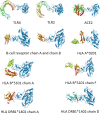Cross-variant proof predictive vaccine design based on SARS-CoV-2 spike protein using immunoinformatics approach
- PMID: 36644779
- PMCID: PMC9831375
- DOI: 10.1186/s43088-023-00341-4
Cross-variant proof predictive vaccine design based on SARS-CoV-2 spike protein using immunoinformatics approach
Abstract
Background: Coronavirus Disease (COVID-19) is caused by the Severe Acute Respiratory Syndrome Coronavirus 2 (SARS-CoV-2). The SARS-CoV-2 virus is evolving continuously. The omicron variant of SARS-CoV-2 has the highest mutation in its spike protein, thus making the presently available vaccine ineffective or reducing its efficiency. Furthermore, the majority of the vaccines are constructed using a spike protein sequence from wild-type SARS-CoV-2. This raises the possibility of the virus evolving to the point where the vaccine's effectiveness is completely lost, even after booster doses. The study aims to develop a predictive vaccine as well as the epitopes for the updating of the vaccine sequences of currently available vaccines. In this study, following the immunoinformatics approach, predictive vaccine construction was done with the help of epitopes present on spike proteins of wild-type, delta, and omicron variants that encompass the majority of variants and possible new variants that arise from the combination of circulating variants.
Results: The vaccine that was constructed was stable and immunogenic. The vaccine was constructed with the help of 18 B-cell epitopes, 5 MHC class I epitopes, and 6 MHC class II epitopes. The epitope conservancy analysis suggests that the vaccine will work for the previously known variant of concern. The vaccine bound to TLR4, TLR2, B-cell receptor chains A and B, and ACE2 receptors with a z score of - 1.4, - 1.7, - 1.4, - 1.7, and - 1.4, respectively, with a cluster size of 121 highest for the ACE2 receptor and 46 lowest for B-cell receptor chain A. The C-ImmSim simulation results indicate that the vaccine is generating both humoral and cell-mediated responses at a sufficient level throughout the month upon injection of the vaccine as an antigen.
Conclusion: The study's findings indicate that the vaccine was both stable and immunogenic, providing a sufficient level of immunity. Following experimental validation, the vaccine can be used, and the epitopes can be employed for therapeutic purposes such as antibody synthesis.
Supplementary information: The online version contains supplementary material available at 10.1186/s43088-023-00341-4.
Keywords: And omicron; COVID-19; Delta; Immunoinformatics; Multi-epitope vaccine; SARS-CoV-2.
© The Author(s) 2023.
Conflict of interest statement
Competing interestThe authors declare no conflict of interest.
Figures





Similar articles
-
Immunoinformatic approach for the construction of multi-epitopes vaccine against omicron COVID-19 variant.Virology. 2022 Jul;572:28-43. doi: 10.1016/j.virol.2022.05.001. Epub 2022 May 10. Virology. 2022. PMID: 35576833 Free PMC article.
-
A novel vaccine based on SARS-CoV-2 CD4+ and CD8+ T cell conserved epitopes from variants Alpha to Omicron.Sci Rep. 2022 Oct 6;12(1):16731. doi: 10.1038/s41598-022-21207-2. Sci Rep. 2022. PMID: 36202985 Free PMC article.
-
Immunoinformatics and MD-simulation data suggest that Omicron spike epitopes are more interacting to IgG via better MHC recognition than Delta variant.Int Immunopharmacol. 2023 Oct;123:110636. doi: 10.1016/j.intimp.2023.110636. Epub 2023 Jul 25. Int Immunopharmacol. 2023. PMID: 37499394
-
Scope of SARS-CoV-2 variants, mutations, and vaccine technologies.Egypt J Intern Med. 2022;34(1):34. doi: 10.1186/s43162-022-00121-z. Epub 2022 Mar 26. Egypt J Intern Med. 2022. PMID: 35368846 Free PMC article. Review.
-
Recent trends in next generation immunoinformatics harnessed for universal coronavirus vaccine design.Pathog Glob Health. 2023 Mar;117(2):134-151. doi: 10.1080/20477724.2022.2072456. Epub 2022 May 12. Pathog Glob Health. 2023. PMID: 35550001 Free PMC article. Review.
Cited by
-
Characterizing the West Nile Virus's polyprotein from nucleotide sequence to protein structure - Computational tools.J Taibah Univ Med Sci. 2024 Jan 16;19(2):338-350. doi: 10.1016/j.jtumed.2024.01.001. eCollection 2024 Apr. J Taibah Univ Med Sci. 2024. PMID: 38304694 Free PMC article.
-
Epitopes screening and vaccine molecular design of PEDV S protein based on immunoinformatics.Sci Rep. 2024 Aug 22;14(1):19537. doi: 10.1038/s41598-024-70579-0. Sci Rep. 2024. PMID: 39174674 Free PMC article.
References
LinkOut - more resources
Full Text Sources
Research Materials
Miscellaneous
